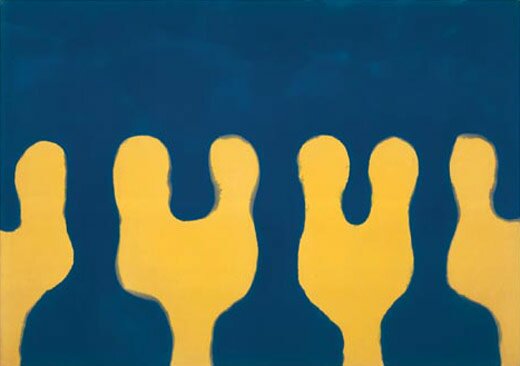Paul Feeley
Posted by ben on 03 Dec 2007 at 03:11 pm | Tagged as: books, design, essays, responses/reviews

I just got an email asking why we hadn’t covered the Paul Feeley show currently on exhibit at Lawrence Markey, and my excuse was that I’m not good at writing about that kind of art. However, it’s an impressive show, and deserves more attention. So I decided to quote from a catalog / book of Feeley’s work put out by Matthew Marks and Lawrence Markey back in 2002. This passage is from a short essay about Feeley written by Lane Relyea. is definitely worth picking up if you are interested in Feeley’s work. I’ll also take this opportunity to scold our San Antonio readers for not attending Lawrence Markey’s openings with more consistency (you know who you are) — he consistently puts together great shows by important artists.
Feeley’s paintings from the ’60s betray too much of High Modernism’s earnest optimism to be characterized as primarily subversive, and yet it’s also hard to see them as bent on autonomy. With their extendable patterns of simple, interlocking forms and their nondeclarative quality gained by the back-and-forth play of assertive and recessive shapes, they’re too suggestive of tiles, fabrics, and other such prosaic materials. These references might in turn place Feeley’s art within [Constructivism], except that there’s no mistaking Feeley for a harbinger of revolution. Feeley’s mature work seems to bear the influence of postwar industrial and commercial design and the intense interest paid to it by college art curricula, lifestyle magazines, and museum curating (including the series of “Good Design” shows MoMA mounted in the early ’50s). In Feeley, as in all these instances, the attempt to merge art and life was made without any nervous glancing at the clock of revolutionary history. Historical time-keeping was also a prominent feature of Modernist painting as Clement Greenberg conceived it, which may help to explain why the critic’s support for Feeley was only lukewarm. Paintings were less likely to participate in grand historical advances if they nestled too comfortably in the private spaces of home and daily social life, where history loses sight of its main actors and staging grounds, its leaders and elections and wars, and instead moves almost imperceptibly.
One Response to “Paul Feeley”
-
on 03 Dec 2007 at 10:18 pm # Chronokinesis